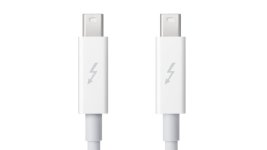- Feb 24, 2011
- 497
[attachment=5]
Intel has finally launched its new peripheral interconnect technology—formerly codenamed "Light Peak"—now branded "Thunderbolt." Developed in cooperation with Apple, which introduced Thunderbolt on its newest MacBook Pro laptops on Thursday morning, the new interconnect is designed to bring workstation-class I/O throughput to mobile workflows as well as serve as a next-generation connector for peripherals, including displays, storage, and video and audio devices.
Intel first announced Light Peak at the Intel Developers Forum in 2009. The proposed standard was intended to replace interconnects like FireWire, USB, and others with fiber optic connections capable of up to 100Gbps bi-directional throughput. Moving to fiber instead of copper allowed increased speeds as well as dramatically longer cable runs. The original demos used a 30m fiber optic cable to transmit dual 1080p video streams, LAN traffic, and files to an SSD RAID setup.
In its initial out-of-the-lab incarnation, Thunderbolt can use either copper or fiber connections for 10Gbps bidirectional communication. That speed is 20 times faster than the theoretical limit of USB 2.0, 12 times faster than FireWire 800, and twice as fast as USB3. According to Intel, however, the 10Gbps isn't just a theoretical peak speed, but usable bandwidth. This allows a single port to communicate with multiple devices simultaneously for a combined throughput of 10Gbps.
Continue reading
Intel has finally launched its new peripheral interconnect technology—formerly codenamed "Light Peak"—now branded "Thunderbolt." Developed in cooperation with Apple, which introduced Thunderbolt on its newest MacBook Pro laptops on Thursday morning, the new interconnect is designed to bring workstation-class I/O throughput to mobile workflows as well as serve as a next-generation connector for peripherals, including displays, storage, and video and audio devices.
Intel first announced Light Peak at the Intel Developers Forum in 2009. The proposed standard was intended to replace interconnects like FireWire, USB, and others with fiber optic connections capable of up to 100Gbps bi-directional throughput. Moving to fiber instead of copper allowed increased speeds as well as dramatically longer cable runs. The original demos used a 30m fiber optic cable to transmit dual 1080p video streams, LAN traffic, and files to an SSD RAID setup.
In its initial out-of-the-lab incarnation, Thunderbolt can use either copper or fiber connections for 10Gbps bidirectional communication. That speed is 20 times faster than the theoretical limit of USB 2.0, 12 times faster than FireWire 800, and twice as fast as USB3. According to Intel, however, the 10Gbps isn't just a theoretical peak speed, but usable bandwidth. This allows a single port to communicate with multiple devices simultaneously for a combined throughput of 10Gbps.
Continue reading

